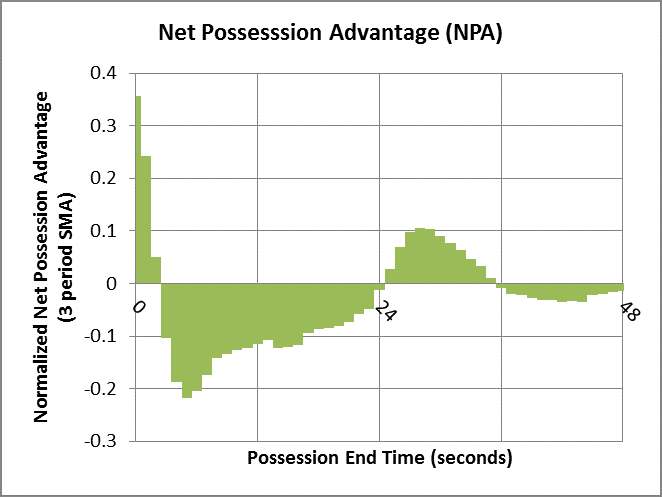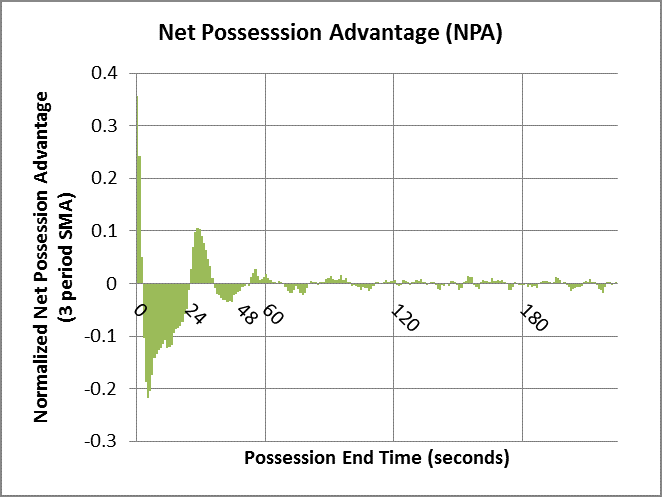When should a team shoot to maximize possessions?
Possession Timing 101 - Introduction to NPA
This is a piece from the Possession Timing 101 multi-part series where we will be diving even further into the topic of possession timing as introduced by the research paper: Optimizing End Of Quarter Shot-Timing In The NBA: "Everyone Knows About The 2 For 1, But What About The 3 For 2?" (pdf). Throughout these posts I hope to: review concepts and results from the research, explore ideas not covered in the paper, and share many more visuals. tothemean is the place to read about strategic possession timing in the NBA.
When should a team shoot to maximize possessions?
The concept of a "2-for-1" is simple: by shooting at a particular time a team can guarantee1 an extra possession in the quarter when compared to their opponent. On the other hand, a question which is not quite as simple is: When should a team take their shot to maximize the likelihood of picking up an extra possession?
In the NBA, where the shot clock is 24 seconds, a shot should obviously be taken sometime prior to 24 seconds remaining2 to ensure the opponent doesn't use up the rest of the clock before you get another possession. Ok…so you should shoot sometime before 24 seconds remaining, what about the other end of the time range?
If a team shoots too early before 24 seconds there is potential for the opponent to perform a quick shot3 which could negate the possession advantage. Makes sense…so shoot sometime before 24 seconds but not too far. How far is too far? When does this start to diminish? What is the optimal time to shoot to maximize the likelihood of an extra possession?
To evaluate such questions, the research first introduced a new metric called Net Possession Advantage (NPA):
NPA represents the number of "extra" possessions that a team will obtain through the remainder of the current quarter (inclusive of the current possession)
Below you can see the historical normalized4 NPA values for a team ending its possession at a particular second across the final 48 seconds of the quarter5. Positive values indicate that if a team ends its possession on that second they are likely to have a possession advantage compared to their opponent6. Oppositely, negative values would suggest the team is likely to have a possession disadvantage7.
As you can see there appears to be four different time periods in the final 48 seconds of a quarter. Let me interpret them for you:
- 0-2 seconds: When a team ends its possession in the final 2 seconds, the opponent will likely not have time for their own possession and therefore the team would be at an advantage
- 3-24 seconds: When a team ends its possession with more than 3 seconds left the opponent is likely going to get its own possession as well3
- 25-35 seconds: "2-for-1" advantage!
- 36-48+ seconds: Opponent "2-for-1" opportunity…
Here are some notable NPA values:
- Possessions ending with less than a second left result in a ~96% possession advantage likelihood
- Possessions ending at 5 seconds result in a ~26% possession advantage likelihood
- Possessions ending at 28 seconds result in a ~62% possession advantage likelihood
None of this information is anything ground-breaking. Looking to get a "2-for-1" and performing "end of quarter shot timing" has likely been going on since the advent of the shot clock. However, when we zoom out from the last 48 seconds we start to see something interesting which hasn't been talked about as much. Here is a chart showing the same information but over the final 4 minutes of the quarter:
As you can see the possession advantage swings continue well beyond the "2-for-1" time period. They are very small but at the same time very noticeable. We will come back to this observation in upcoming posts but if you can't wait, then feel free to read the paper.
Now to address what you are probably all thinking at this point: If the maximum "2-for-1" possession advantage appears at 28 seconds, does this mean teams should try to "time" all their possessions to end at that point? The answer is: NO absolutely not!
I really want to like NPA. The graph are intuitive. The numbers make sense to think about. However the flaw with NPA is that it doesn't take into account the value of a possession. A half court buzzer beater is not going to provide the same value as a "run the clock out and get the final shot" possession. However, we need to start somewhere and NPA highlights one of the building blocks for understanding optimal possession timing: possession ending time does matter. So take note and I promise it will get more interesting from here…
Stay tuned for more posts in the Possession Timing 101 multi-part series.
-
Well maybe not guarantee, obviously any event which resets the shot clock for the opponent (offensive rebound, foul, etc) or a quick possession by the opponent can wreak havoc on an assumption like this ↩
-
We are focusing on the NBA here but the same concepts could be applied to NCAA basketball. The problem with the NCAA is that there are only two halves instead of four quarters so there are less opportunities to take advantage of ↩
-
Possession value (i.e. the value of rushed shot being different than a regular shot) is ignored in the context of this post but this will obviously be coming up in future posts ↩ ↩2
-
The NPA metric will always be between 0 and 1 (did a team get an extra possession or not?). In the chart the data is normalized (by subtracting .5) to better highlight the large swings of advantages. ↩
-
For a more thorough explanation and additional details, refer to the paper ↩
-
By advantage we mean more than a 50% chance of getting an extra possession (inclusive of current possession) ↩
-
By disadvantage we mean more than a 50% chance of having an equal number of possessions compared to their opponent (inclusive of current possession) ↩

